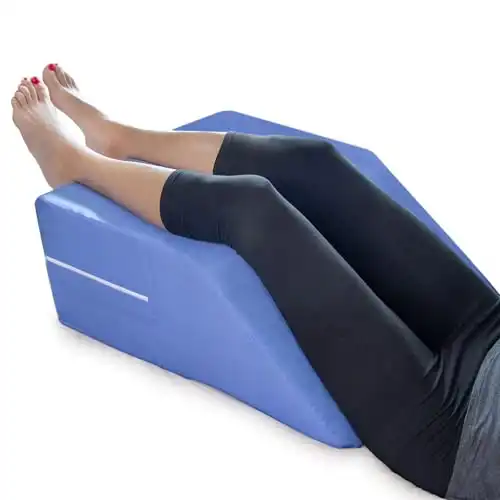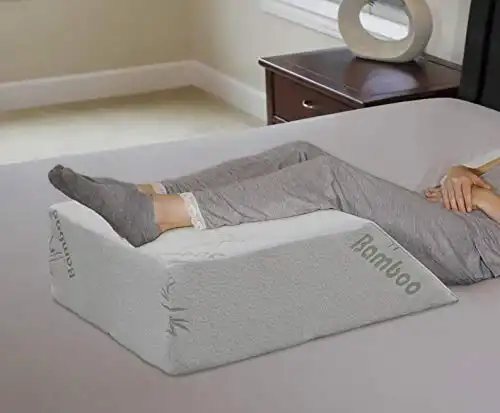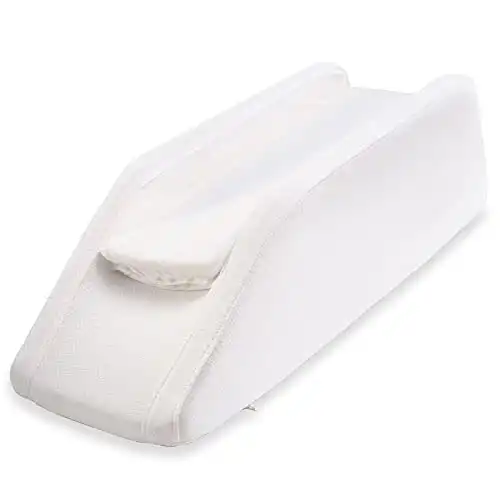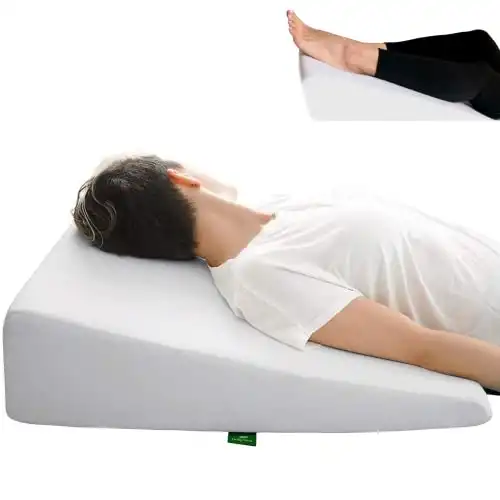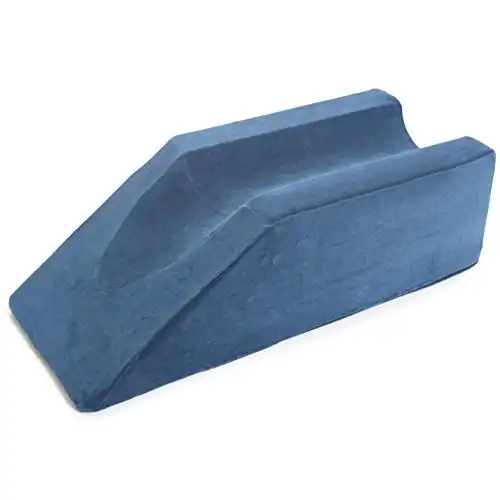Knee replacement can be a painful and trying procedure. Depending on how well the procedure goes and how well cared for the knee is post-surgery, the patient may take anywhere between 4 to 6 weeks to fully recover from the procedure.
One of the things that can reduce the intensity of at nighttime when the patient is sleeping is an .
Knee pillows come in several varieties; however, for people who are recovering from total knee replacement (TKR) surgery, wedge-shaped knee pillows are the most common variety.
In this article, we review some of the best knee pillows after knee replacement for the elderly. The table below provides a quick snapshot of our top picks, and you can scroll down for detailed reviews and discussions.
|
$59.99
|
N/A
|
$49.99
|
$55.99
|
N/A
|
Contents
The RICE Recovery Method
The most commonly used phrase after knee replacement surgery and when recuperating from it is the “RICE” method, which stands for rest, ice, compression, and elevation. Most total knee replacement (TKR) surgeries will end with advice to follow the RICE principle, as it can help to avoid further inflammation in the knees and ensure that the injury heals quicker.
During the recovery period from your surgery, ice packs and an elevation pillow can be of help.
The leg elevation aspect of RICE is taken care of by the knee pillow, which we will be discussing further in this article.
Elevating the leg at 35 degrees from the hip is a safe and effective way to reduce total blood loss1 by 25%. Therefore, leg elevation is very important after TKR.
The video below shows what one should expect after having knee replacement surgery.
How to choose the best knee pillow after a knee replacement surgery
There are several factors to consider when choosing an for use after TKR. Listed below are some of the parameters.
Shape
Most of the pillows for post knee replacement surgery are wedge-shaped (like a triangle), which holds the knee and leg at an incline to the rest of the body.
Size
Knee pillows can come in a variety of lengths, widths, and heights. Ideally, they should be able to cushion your knees based upon the size of your foot.
Incline
The large, thick portion at the end of the incline should measure at least 7 inches, and in some cases, it can go up to even 12 inches. The comfort zone between a slow incline and a high incline really depends on personal choice.
You may also like Driving After Knee Replacement
Composition
Most knee pillows are made with memory foam. The pillow cover may be composed of nylon, polyester, bamboo, or another fabric material. Look for a cover type that is most comfortable for you – one which does not make you sweat too much and is comfortable for your skin.
Covers
The pillow should ideally have a machine washable cover so that it can be easily washed at regular intervals.
Cost
Wedge pillows can cost a lot of money, but there are cheaper options available as well. Price is often related to the quality of the materials and durability.
Stability
If you tend to move throughout the night, a that has a steeper slope and is lightweight can shift around, disrupting its optimum functional position. For restless sleepers, it is recommended to use a heavier that will hold in place and give you comfort throughout the night.
Breathability
Pillows that have an outer cover made of breathable materials like nylon, bamboo, and polyester can help prevent the accumulation of sweat and make you feel a more comfortable, especially if you tend to have night sweats or just feel hotter during sleep.
You may also like Can You Run After Knee Replacement
Firmness
Typically, a mattress with memory foam may be less firm than that which is made from high-density foam. That said, firmness of a knee pillow is not as critical a decision as with a mattress, and can be a matter of personal preference here.
Other factors
Most retailers offer trials, which means that you can test the for 30 to 90 nights and return it if it doesn’t suit you. Shipping and return policies are also important, especially the cost of shipping back. Of course, warranty coverage is also an important factor and can vary by brand, model, and retailer. Most warranties cover defects within 3 years. Be sure not to buy one that lacks warranty coverage.
In the next section, we will discuss our top picks for knee pillows after knee surgery.
Best Recommended Knee Pillows After Knee Replacement
#1 – DMI Ortho Bed Wedge
The Ortho Bed Wedge by DMI is one of the best wedge pillows out there. It comfortably elevates the legs at the right angle above your heart so that you can have a better circulation of the blood and lesser pressure on the lower back.

It helps relieve discomfort from TKR by taking the pressure off sensitive areas, thus helping you sleep at ease throughout the night.
It also lets you easily recover after a knee surgery by elevating the legs at the right angle instead of clumsily stacking pillows or other items that offer a similar effect.
The DMI Ortho Bed Wedge has a zippered machine washable cover that is easily removable and measures only 10 x 20 x 30.5 inches.
Pros
- Available in 6, 8 and 1- inch thickness as per requirement
- Lightweight (weighs only 3.2 pounds)
- Provides firm support for the legs at the appropriate height
- Extra-wide platform to keep your legs in the proper position
- Soft enough to keep you well rested for the night
Cons
- Some users have complained that it gives off a chemical smell after initial purchase
- The pillow may be too hard for some users
You may also like Medicare Knee Replacement Age
#2 – InterVision Ortho Bed Wedge Pillow
The Intervision helps to improve

It comes with a high-quality, machine-washable cover made from bamboo which feels smooth and is easy to clean. The product is extremely lightweight at only 3.2 pounds.
The product also comes with a 30-day full refund policy, so that you can try it out and feel whether it suits your need.
Pros
- Two-layer design: memory foam on top and hard foam below for comfort as well as support
- Improves circulation, reduces stress on spinal cord
- Comes with a high-quality machine washable cover
- Lightweight
Cons
- The product is too firm for a few previous customers.
- Some customers have complained of an unpleasant smell
#3 – PureComfort – Adjustable Leg, Knee, Ankle Support and Elevation Pillow
The PureComfort knee pillow keeps the legs in place during sleep by using a custom design that accommodates both cold as well as hot packs. The pillow reduces swelling and reduces knee pain by keeping the legs at an incline to the body.

It can accommodate cold or hot packs for complete comfort.
It is a fully adjustable .
Pros
- Keeps that leg inclined at the perfect angle
- Fully adjustable
- 100-day return guarantee
Cons
- The product is not tall enough according to a few customers.
You may also like Pros and Cons of Partial Knee Replacement
#4 – Wedge Pillow for Sleeping by Cushy Form
The Cushy Form knee pillow has a high-density memory foam at the top that maximizes comfort while fitting your body shape for the best results.
No products found.This cushion has a machine washable cover.
The product is covered by a 100% money-back guarantee.
Pros
- High-density memory foam top
- Removable and machine washable cover
- Firm and does not collapse easily, which can also help with longevity of the product
Cons
- The pillow keeps slipping due to low weight
- Some customers have complained that the pillow is quite stiff
No products found.
#5 – Milliard Foam Leg Elevator Cushion
This pillow adequately angles injured knee joints for optimal healing. It reduces swelling by lowering the flow of blood to the affected area.

It keeps the legs in place to prevent further injury due to movement during sleep.
It is made from polyurethane foam with a 45 degree angled ramp and Includes a removable and machine-washable velour cover. It measures 32 x 13 x 19.5 inches.
Pros
- Angles injured knee joint for optimal healing
- Reduces the flow of blood to the injured area
- Made with polyurethane foam at a 45 degree angled ramp
- Removable and machine-washable cover
Cons
- May not work well for shorter people
You may also like Best Age for Knee Replacement Surgery
Frequently Asked Questions
Q. What might require a knee replacement?
Knee replacement surgery is most commonly performed to help relieve severe pain in the knee that may be caused by osteoarthritis. Individuals requiring knee replacement surgery typically have trouble walking, climbing, and sitting down and standing up. Certain people may also experience knee pain at rest.
Q. What is involved in a knee replacement?
Prior to the procedure, the patient will receive either general or local anesthesia. In general anesthesia, the patient will be made unconscious or put to sleep. Local anesthesia will involve spinal anesthesia, where you will be unable to feel pain below your waist and you will remain awake.
The knee replacement operation will last around 2 hours. During your procedure, you knee will be kept in a bent position to exposure the facets of the joint. An incision is made at the joint, your kneecap will be moved aside, and damaged joint surfaces will be cut away. After this process, your surgeon will attach pieces of an artificial joint. Your surgeon will bend and rotate your knee to test for proper mechanical function before closing the region.
After your operation, you will be brought to a recovery room for a couple hours, and you may stay as long as you require. Most patients can go home the day of their surgery, and you will be prescribed medications to help with knee pain. Now, your recovery and rehabilitation process begins!
Q. How do I recover from a knee replacement?
During your recovery after your surgery, you will be encouraged to move your foot and ankle help increase blood flow around the region and avoid blood related complications. You may also be given blood thinners and advised to wear a compression boot to help this matter.
In addition to movement, you will be advised to do breathing exercises and gradually increase you level of activity as you recovery. You may see a physical therapist who can provide you with advice about how to do exercise that are appropriate for the rehabilitation of your knee.
Last but not least, you can support your knee during sleep with a knee pillow to help elevate your knee as it recovers!
Parting Words – Elevate to Rehabilitate
Elevation is an important aspect during the period following a knee replacement surgery. We have discussed in this article some of the best knee pillows out there which can help you along with your recovery by providing you with the right elevation so that you can sleep peacefully at night and help your knee along the path to recovery.
There are several factors to consider when shopping for a knee pillow, most importantly of which are the incline and the quality of the material. We believe that any of the pillows discussed above will help you along the path to recovery.
Our favourite pick for knee pillow is the DMI Ortho Bed Wedge Elevated Leg, a great option that comes in various thicknesses and provides firm support and an extra wide platform for stability..
For a more value-oriented option, you may also consider the InterVision Ortho Bed Wedge Pillow, another solid option with a memory foam layer for added comfort.
Knee replacement is a tough surgery to recover from, and we hope that all those who are reading this article are able to make maximum use of the tips that we have provided.
References
- https://www.thekneejournal.com/article/S0968-0160(02)00076-5/abstract

